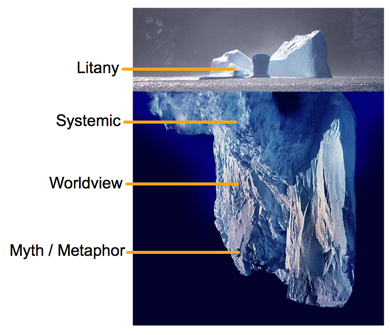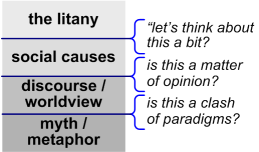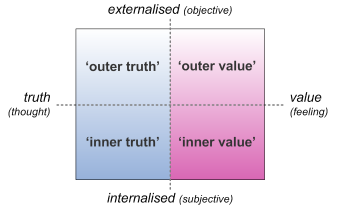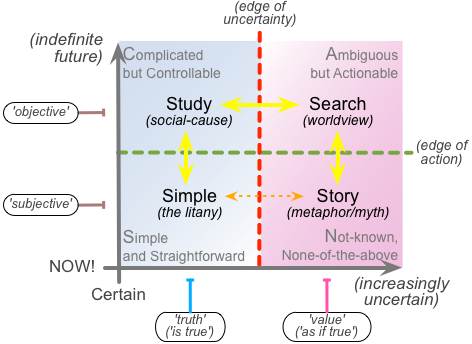Two SCAN notes – 2: Causal Layered Analysis
Regular readers of this blog will know I refer quite often to one of the core techniques in futures-studies, Sohail Inayatullah’s Causal Layered Analysis (CLA). But as of a couple of weeks ago, you won’t find any reference to it on Wikipedia: instead, there’s just a deletion-page. It’s become yet another victim of a culture (or cult, even?) of self-appointed ‘deletionists’, striving to rid Wikipedia of anything that they regard as non-factual and ‘non-scientific’.
There are the usual interesting twists, of course: one the key deletionists in this specific example has created large numbers of Wikipedia pages on military-vehicles and race-cars, which evidently he thinks are important – yet has seemingly assigned himself the ‘rights’ to delete a key Wikipedia reference-page for a formal discipline about which he has no personal or professional knowledge whatsoever. Another editor was outright dismissive, deriding the entire CLA Wikipedia page as ‘meaningless gibberish’, without noting the irony that the exact same could be said of every Wikipedia page that included mathematical symbols – which are likewise ‘meaningless’ to those who don’t know what they mean, or how to use them. All of which is kinda worrying for a lot of disciplines currently represented in Wikipedia – including enterprise-architecture and related fields…
The key complaint, apparently, was that, for those who don’t know about such routine linguistic-analysis terminology such as ‘deconstruction‘, the article was “too technical”. In that sense, yeah, it was kinda technical, and perhaps needs to be simplified – I hesitate to use the phrase ‘dumbed-down’, but probably does apply here – for the more-general audience on Wikipedia.
Unsurprisingly, there’s a lot of effort already happening on that right now in the CLA community. It struck me, though, that one way we could add to this would be to crosslink CLA to the kind of context-space mapping used in the SCAN framework on sensemaking and decision-making. I’ve already done this a couple of times before, such as in the posts ‘Causal Layered Analysis, SCCC and Cynefin‘ and ‘SCAN and Causal Layered Analysis‘, but it seems worthwhile to update those with to link to some of the more recent work on SCAN – particularly around narrative and story.
The usual description of CLA is that sensemaking and decision-making are built upon a set of conceptual layers that interact with each other in somewhat of a causal-like way, and that we can assess and analyse through techniques such as linguistic-deconstruction – hence, in turn, ‘Causal Layered Analysis’.
CLA identifies four distinct layers of sensemaking and decision-making:
- the litany, the world of the tabloid-newspaper, the everyday of ‘the world as it should be’ – or, more often, the ‘litany of complaint’ that it’s not ‘as it should be’.
- the systemic layer, the layer of social causation – “the data of the litany are explained and questioned at this level”.
- the worldview layer – the stories and narratives through which we decide what is ‘relevant fact’ and what is not, and in which “the ways in which different stakeholders construct the litany and system are also explored”.
- the core of deep-myth and metaphor – “the unconscious emotive dimensions of the issue”, the culture’s creation-myths and suchlike that underpin assertions about what is and is not supposedly ‘self-evident’.
The layers are typically portrayed as a vertical stack, and often as an iceberg, with only ‘the litany’ layer visible on the surface:
And, as Sohail put it in a community-email, an initial CLA-assessment of the Wikipedia deletionists’ perspective might be as follows:
- the litany – number of deletions per day
- systemic – ensure entries are not propaganda based but scientific with proper citation and references
- worldview – bring some order into a overly chaotic knowledge system
- metaphor – weed out the crazies, the irrational
Now given that [the futures-studies community] accepted the conditions and made the systemic changes required – in text citation and external citation, evidence of use of cla in scholarship, etc and the systemic solution has been rejected, for me, more often than not, that means that there is a worldview/metaphor issue
[Editors’] worldview is that …our changes are [interpreted as] rigged and thus not scholarship but ideologically motivated…ie the weeds are ganging up and trying to protect the ecoscape. [Editors’] solution, more deletions ie go to what is easiest, the technical approach. Do what is one is doing but with more force.
Which I’d see as a valid and useful way to interpret the problems. It also provides a useful suggestion as to how to tackle the problem, namely to treat it as a ‘worldview’-type issue, rather than trying to fix it at the ‘systemic’ level – because adding more data is not going to help if the source of those data is not believed or trusted.
Looking at this with an enterprise-architect’s eye, though, two themes up for me. One is that in some ways I’m almost less interested in the detail within the layers themselves, than in the conversations that take place between the layers – because that’s how questioning and movement actually start to happen:
The other is that – again as in enterprise-architecture – I’m perhaps not so sure that ‘layers’ is the most useful metaphor here. My first attempt at a cross-map between CLA and SCAN, some eighteen months back, suggested that there’s at least one more dimension involved in this – leading to the following cross-map:
The horizontal dimension here is effectively a re-map of CLA’s ‘depth’-dimension to SCAN’s certainty/uncertainty dimension – which is straightforward enough, especially if we use the more-recent ‘side-axis’ mapping for SCAN’s axes (of which more below). But the vertical-axis – shown above as ‘Now!’ to ‘infinity’, but perhaps better described as ‘time available before decision must be made for action’ – also here implies that ‘social-cause’ and ‘worldview’ occur at some distance from the point-of-action. In a literal sense, they only occur when there’s sufficient time to step away from the action: yet it also means that they are often not used – and maybe cannot be used – actually at the point-of-action. When at the point-of-action – this suggests – the only sensemaking available is either ‘the litany’, or deep-myth: nothing else. Which does seem to accord with what we see of people’s actual choices at the point-of-action: not what they think they will do, or say they will do, but what they actually do – especially under times of stress.
Since that initial cross-map, some eighteen months back, I’ve been doing quite a lot of rethink about the nature of SCAN and how to use it in various ways in real-world practice. Part of that exploration took me back to some of its earliest roots, in a well-known Jungian-style frame:
Those problems with the deletion of the CLA Wikipedia page occurred at the same time I was working on the ‘dung-beetle’s tale‘ slidedeck on SCAN and systems-thinking, for the Integrated-EA conference, which in part led to the ‘edges’ ideas in the previous post, but in turn led to a kind of minor epiphany about SCAN and CLA, focussing on the edges between ‘domains’ in both SCAN and CLA alike, and also using a cross-map to that Jungian frame:
A whole stream of ideas arise from this cross-map.
One is that ‘objectivity’ (as in ‘Study’ and ‘Search’) is a luxury that only becomes available when we have the time and distance to be able to stand back from the fray: when we’re in the midst of the action, ‘objectivity’ is an option we simply don’t have.
Another is that when we’re in the action, the only support we have are overt surface-level ‘rules’ (the litany; Simple) and often non-conscious / non-surfaced principles and guidelines (metaphor/myth; Story). Related to that is that whilst the regular edges between each of the CLA ‘layers’ (litany :: social-cause; social-cause :: worldview; and worldview :: metaphor/myth) are all identifiable, and largely supported in one form or another, the edges that jump between non-adjacent ‘layers’ (especially litany :: metaphor/myth) are often much harder to describe, and to get people to identify in action.
[A side-theme here is that, rather than ‘Simple’, a more accurate relabel of ‘the litany’ would be ‘Surface’ – because it’s all about what happens at the surface, unexamined, unquestioned. (It’s also, very often, about ‘rules’ that are supposed to apply to ‘the Other’ – “they should…”, “they ought not to…” – without much examination about whether or how the same ‘the rules’ and responsibilities should also apply to the Self…) In practice, though, although the noun-form of ‘Surface’ does work well for this purpose, the verb-form of ‘Surface’ is almost exactly what is not happening here: the surface-layer assumptions are not being surfaced at all. Hence, in practice, probably simpler to stick with SCAN’s label of ‘Simple’?]
Anyway, in a bit more detail:
— ‘the litany‘ (Simple): ‘rules’ and other assumptions applied at the point of action; as purported ‘truth’, the real-world is deemed to be ‘wrong’ if it does not align with these ‘truths’; the risk is a collapse into panic (as per ‘the edge of panic’, in the post on edges in SCAN) if the real-world forces a pushback against the assumptions of ‘the rules’
— ‘social-cause‘ (Study): algorithms and other analyses are applied to assess the outcomes of interactions between ‘the rules’ and the real-world; analysis takes place ‘within the box’ of a supposed logically-consistent frame of reference (example: ‘rational-actor’ theory in economics); the risk is circular-reasoning (as in, again, ‘rational-actor’ theory), generating ‘rules’ for Simple that are invalid in real-world practice
— ‘worldview‘ (Search): patterns and probabilities are used to acknowledge real-world ambiguity and ‘break out of the box’, with a re-emphasis on value rather than purported ‘truth’; the catch is that each worldview in effect forms another kind of box, and there’s always a larger box…
— ‘metaphor/myth‘ (Story): principles and guidelines arising from (usually culturally-determined) deep-myth and deep-metaphor are used as ‘seeds’ around which meaningful-value can coalesce when acting within inherent-uncertainty (‘chaos’) in real-time action; the catch is that if the deep-myth has not been surfaced and accepted as conscious choice, then the choices behind decision and action within ‘chaos’ will remain largely unconscious and, in effect, not as choice at all
A mode we might describe as ‘Simplistic‘ occurs when the unconscious assumptions from Story are rationalised as the intentional choices of Simple – in other words, as unacknowledged and unsurfaced ‘truths’. One of the core purposes for using CLA, and related tools such as Nigel Green and Carl Bate’s VPEC-T (Values, Policies, Events, Content, Trust), is to identify when Simplistic decision-making is in use, and instead surface the assumptions so as to choices more intentional, even at the point-of-action – and also surface, negotiate and ‘re-solve’ the wicked-problems that arising from equally-valid yet clashing deep-myth assumptions.
(Nigel Green gives a very good example of the latter in his work with the [UK] Justice system. One of the core deep-myth drivers for the police is to get out on the street, do everything fast, keep paperwork to an absolute minimum; by contrast, the prosecution-service need everything done slow, precise, careful, everything documented to the hilt. Clearly, there’s a clash there, right down to the roots. On its own, surfacing the clash doesn’t help much: all it does is trigger arguments as to which side is ‘right’ – missing the point that’s about value, not ‘truth’. However, there is a node of agreement between the two deep-myths, in that both sides not only want criminals caught, but successfully prosecuted: this point of contact provides an anchor around which negotiation between them becomes possible.)
We can also note that both Study and Search (‘social-cause’ and ‘worldview’) take place at distance from the action. There’s therefore a very real risk that, unless they are linked to Simple and/or Story, all of their work may be dismissed as ‘ivory tower’ – or, as perhaps the case in the deletion of the CLA Wikipedia page, as too ‘academic’ or ‘technical’ to be of any practical use. Completing the linkage across the whole – as described in the SCAN ‘edges’ post – is absolutely essential if valid and useful outcomes are to be achieved in the respective context.
Two last items, arising from another cross-map, this time between SCAN and skill-levels:
The first is it’s possible that people may not become fully aware of deep-story and deep-metaphor in a given context – and that they have choices about how that Story impacts upon them – until they’re able to reach some form of ‘mastery‘ of context and its skills. Or, perhaps – as we do see in practice – that there’s a kind of recursion and also inversion there: people touch on the deep-story, even at quite early stages in skills-development, which can help them reach towards mastery, in fact becomes a motivational driver to want to develop more mastery in that skill. Part of the latter, perhaps, is because – as described in the ‘dung-beetle’ slidedeck – the SCAN ‘Not-known’ is the only place where ‘the new’ can occur, and where change can actually happen: which in turn connects to the drive towards mastery – the driver towards ‘the new’, the next level of ‘masterpiece’ – and also to become part of and even ‘at one with’ the deep-Story.
The other point is – as discussed in a earlier post on skill-levels and certification – the ‘apprentice‘ skill-level can be highly-problematic: it engenders an often spurious sense of ‘certainty’ in knowledge, precisely because it has not yet attempted to tackle the deeper ambiguities and uncertainties that are what make it a genuine skill (rather than just the execution of a predefined algorithm). The risk is that this lack of domain-knowledge can trigger exactly the kind of over-confidence (and, bluntly, arrogance) that we see in situations such as the deletion of the CLA Wikipedia-page by people who were, in a literal sense, incompetent to judge it. Those kind of concerns and awarenesses perhaps need to be more explicitly included in future developments of CLA and the like.
Anyway, best leave it there for now: hope it’s useful to someone, perhaps?






There is a section about Causal Layered Analysis in http://en.wikipedia.org/wiki/Futures_techniques